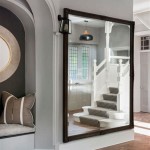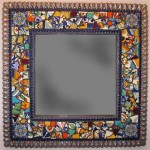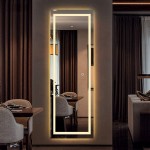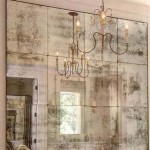How To Tell If Your Mirror Is Double Sided
The inquiry regarding whether a mirror is double-sided, often referred to as a two-way mirror, presents itself in various contexts, ranging from personal curiosity to security concerns. The distinction between an ordinary mirror and a two-way mirror hinges on how light and visibility are managed between the two spaces it separates. A standard mirror reflects light back into the room it faces, providing a clear reflection. Conversely, a two-way mirror, under specific lighting conditions, allows visibility from one side while appearing as a standard mirror on the other. Determining the nature of a mirror requires careful observation and, in some cases, the application of relatively simple tests.
The fundamental principle behind a two-way mirror lies in its construction. It is not inherently different in material from a standard mirror; rather, the difference lies in the reflectivity of its coating. A standard mirror has a thick, opaque reflective coating applied to the back of the glass, usually made of silver or aluminum. This coating reflects the vast majority of light that strikes it, resulting in a clear and bright reflection. A two-way mirror, on the other hand, has a significantly thinner, semi-transparent coating. This thinness allows a portion of the light to pass through the mirror, while the remaining portion is reflected. The visibility through the mirror depends on the relative brightness of the spaces on either side. If the room on one side of the mirror is brightly lit, and the room on the other side is dimly lit, the mirror will appear reflective from the brightly lit side and transparent from the dimly lit side.
Understanding the physics of light and reflection is crucial in comprehending how two-way mirrors function. The amount of light that is reflected versus transmitted is directly influenced by the thickness of the reflective coating and the intensity of light in each room. This interplay between light intensity and coating thickness is what creates the illusion of a standard mirror on one side and a transparent surface on the other. This effect is exploited in various settings, including interrogation rooms, retail environments, and security observation posts.
The Finger Nail Test
One of the most commonly cited methods for determining if a mirror is double-sided is the "finger nail test." This involves placing a fingernail against the surface of the mirror. In a standard mirror, there will typically be a noticeable gap between the fingernail and its reflection. This gap represents the thickness of the glass. The reflective coating is applied to the back surface of the glass, creating this distance. However, if the mirror is a two-way mirror, the fingernail will appear to be directly touching its reflection, or at least very close to it. This is because the reflective coating is on the surface of the glass, or very close to it, eliminating or minimizing the gap.
It is important to exercise caution when relying solely on the finger nail test. The accuracy of the test can be affected by factors such as the thickness of the glass used in the mirror's construction. Some standard mirrors may use thinner glass, which can reduce the apparent gap and potentially lead to a false positive. Conversely, some two-way mirrors may be constructed with a layer of clear material on the viewing side to protect the semi-reflective coating, creating a small, deceptive gap. Therefore, while the finger nail test can be a helpful initial indicator, it is not foolproof and should be used in conjunction with other methods for a more accurate assessment.
Furthermore, the visual perception involved in the finger nail test can be subjective. What one person perceives as a noticeable gap, another may interpret as minimal. This subjectivity can introduce uncertainty in the assessment. It is therefore recommended to use this test as a preliminary screening tool, and to follow up with more definitive methods if there is any doubt.
The Light Test
Another method for identifying a two-way mirror involves manipulating the lighting conditions surrounding the mirror. This test is based on the principle that the transparency of a two-way mirror is dependent on the relative brightness between the two spaces it separates. To perform this test, the room on the side of the mirror in question should be darkened significantly, if possible even completely. A flashlight or a bright light source should then be positioned close to the surface of the mirror. The intent is to overpower the light coming from any potential observation room behind the mirror.
If the mirror is indeed a two-way mirror, shining a bright light on it while the adjacent room is dark will allow the observer to see through the mirror. The light will penetrate the thin reflective coating, illuminating the space behind the mirror. This will reveal any objects, people, or activities that are present in the observation room. If the mirror is a standard mirror, no such view will be possible. The opaque reflective coating will block the light and prevent any visibility through the mirror.
It's crucial to ensure the room on the suspected observation side is as dark as possible. Any ambient light in that room can reduce the effectiveness of this test and make it more difficult to see through the mirror. Furthermore, the closer the light source is to the mirror's surface, the better the chances of revealing the other side. This is because a closer light source provides a higher intensity of light, which is more likely to overcome the reflective properties of the two-way mirror.
The Sound Test
The sound test is a less definitive, but often overlooked, method for potentially identifying a two-way mirror. This test involves tapping on the surface of the mirror and listening to the resulting sound. A standard mirror, being mounted against a solid wall or backing, will typically produce a dull, flat sound upon tapping. In contrast, a two-way mirror, often installed as part of a larger wall panel or with a space behind it for observation, may produce a hollow or echoey sound.
The rationale behind this test lies in the difference in the mounting structure and surrounding space. A standard mirror is usually affixed directly to a solid surface, which dampens the vibrations caused by tapping and results in a muted sound. A two-way mirror, however, is often part of a more complex structure, with air space or a void behind it to accommodate an observation room. This air space allows the sound waves to reverberate, creating a hollow or echoey effect.
However, it's essential to acknowledge the limitations of the sound test. The accuracy of this test is highly dependent on the specific installation of the mirror and the surrounding wall structure. A standard mirror might be mounted in a way that leaves a small air gap behind it due to an uneven wall surface, potentially producing a slightly hollow sound. Conversely, a two-way mirror could be installed with sufficient backing material to dampen the sound and mimic the sound of a standard mirror. Therefore, the sound test should be considered only as a supplementary indicator and not a conclusive method for determining if a mirror is double-sided. It is best used in conjunction with other, more reliable tests like the finger nail and light tests.
In conclusion, while each test possesses certain limitations, employing a combination of these methods – the finger nail test, the light test, and the sound test – can significantly increase the accuracy of determining whether a mirror is a standard mirror or a two-way mirror. The most definitive test is generally the light test, but it requires the ability to control the lighting conditions on both sides of the mirror. The finger nail test provides a quick initial assessment, while the sound test offers supplementary information. By carefully considering the results of all three tests, a more informed judgment can be made regarding the nature of the mirror.

How To Tell If A Mirror Is Two Way Or Not 8 Steps With Pictures
I M In A Room With Mirror On One Wall How Can Tell If It Is 2 Way Someone Watching Me The Other Side Quora

How To Tell If A Mirror Is Two Way Or Not Quora

Tips For Identifying Whether Your Mirror Is Two Way Or Not Ledmyplace

How To Tell If A Mirror Is Two Way Or Not 8 Steps With Pictures

How To Tell If A Mirror Is Two Way Or Not 8 Steps With Pictures

How To Tell If A Mirror Is Two Way Or Not 8 Steps With Pictures

How To Tell If A Mirror Is Two Way Or Not 8 Steps With Pictures

Touch Your Mirror To Know If Someone S Watching You
How To Tell If A Mirror Is Two Way Or Not Quora








